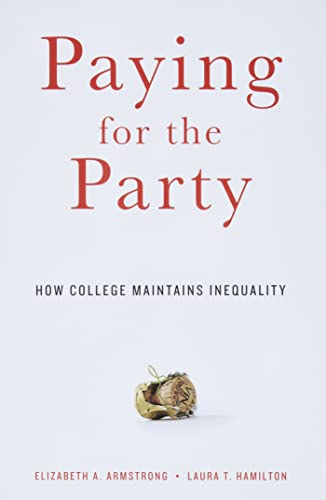Paying for the Party
How College Maintains Inequality
Elizabeth A. Armstrong; Laura T. Hamilton
BOOK REVIEW

In the cacophony of modern education, Paying for the Party: How College Maintains Inequality emerges as a piercing cry against the facade of meritocracy that dominates our universities. Authors Elizabeth A. Armstrong and Laura T. Hamilton navigate these turbulent waters with a critical lens, exposing how social stratification masquerades under the guise of academic opportunity. This isn't just another dry academic tome; it's an electrifying exploration of the corrosive impact that institutional structures have on the very fabric of aspiration and equality in higher education. 🎓
Here lies the revelation: many believe college is the great equalizer. Yet, Armstrong and Hamilton delved deep into the lives of college students at a large Midwestern university and unearthed unsettling truths that might keep you up at night. They meticulously reveal how social class, more than talent or hard work, determines educational outcomes. As students navigate their college years, they are often funneled into party cultures or isolated from valuable networks, reinforcing the very inequalities that the institution purports to dismantle. The frighteningly stark reality is that the college system actively reproduces the social hierarchies we claim to wish away.
Armstrong's and Hamilton's prose pulsates with urgency, making you feel the weight of their findings. They dive into the narratives of students from diverse backgrounds, each grappling with their own aspirations amid the harsh realities of funding gaps, social isolation, and systemic indifference. The book doesn't shy away from the disturbing candidness of its conclusions: privilege masks itself in the guise of connections-relationships, friendships, and networks that can either propel an individual forward or leave them stranded in mediocrity.
The emotional depth of this work resonates through its portrayal of the students' experiences-joyful moments of camaraderie juxtaposed against the harsh realities of economic and social barriers. It's a rollercoaster of feelings, from the giddy highs of newfound friendships to the ominous lows of socioeconomic limitations. Do you feel that tension? It's palpable. This is the stark juxtaposition of college life, where the quest for higher learning often paves the way for deeper social divides, and it challenges you, the reader, to confront your own beliefs about education and equality.
A common critique of Paying for the Party touches on its potential to provoke guilt among its readers-those who benefited from the very system it critiques. But must we dismiss its arguments simply because they strike a nerve? Instead, let's engage with this discomfort. The work dares us to question the status quo, to examine our own complicity in the perpetuation of inequality, and offers a sobering reminder that education, while liberating, can also entrench social divides.
The historical context surrounding this investigation is crucial; Armstrong and Hamilton conduct their inquiry in a post-recession America, where financial strain on families has intensified. The authors deftly connect these larger socio-economic trends with the personal struggles of their participants, revealing an intricate tapestry of choices dictated by economic necessity rather than individual merit.
As Paying for the Party ripples through the consciousness of its readers, it ignites conversations beyond its pages. It has influenced educators, policy makers, and students alike-sparking movements aimed at rethinking how we approach higher education and its role in society. Those touched by this work have been inspired to advocate for policy changes, ensuring that access to education is equitable and that support systems are in place to foster genuine opportunities for all.
Such a profound examination of our educational landscape begs the question-what kind of system do we want to create? Each page is a call to arms, a demand to dismantle the inequities that underlie our educational paradigms. We find ourselves at a crossroads: cling to outdated ideals or embrace a path towards inclusive progress.
Ultimately, Paying for the Party is not just a critique; it's a manifesto. A manifesto encouraging you to look beyond the textbooks, to question the entrenched inequalities that have defined your educational journey and to seek change, both in perception and in practice. What will you do with this knowledge? This is not merely an academic exploration; it's a challenge to upend the complacency that surrounds us. Your move. 🌍
📖 Paying for the Party: How College Maintains Inequality
✍ by Elizabeth A. Armstrong; Laura T. Hamilton
🧾 344 pages
2015
#paying #party #college #maintains #inequality #elizabeth #armstrong #ElizabethAArmstrong #laura #hamilton #LauraTHamilton